Abstract
Induced bronchoconstriction in normal subjects can be transiently reversed by a deep breath (airway hysteresis). The mechanisms of airway hysteresis are not fully understood. The aim of these studies was to determine whether the nature of the deep breath (slow or fast inspiration, five or 10 second breath hold) affects the resultant bronchodilatation. Bronchoconstriction was induced in 10 normal subjects by inhalation of histamine until specific airway conductance (sGaw) was halved (mean (SEM) post-histamine sGaw 0.099* (0.009) s-1 cm H2O-1). A subsequent deep breath to total lung capacity (TLC) increased sGaw by 57% (13%) and neither the rate of inspiration to TLC nor periods of breath holding at TLC produced a significantly different degree of bronchodilation. Reducing the volume of the deep breath produced progressively less bronchodilatation and this was no longer significant after a breath to 68% (2%) TLC. To determine whether the volume of the deep breath or the accompanying increase in transpulmonary pressure (PstL) was responsible for the effect on sGaw, subjects were studied with an oesophageal balloon in place with and without their chest strapped. Subjects took a deep breath to a PstL of 20 cm H2O after bronchoconstriction had been induced by histamine. The degree of bronchodilatation (mean (SEM) %) was not significantly different (strap on 25 (6), strap off 36 (5)) even though significantly larger lung volumes (as % TLC) were reached with the strap off (strap on 57 (2), strap off 78 (3)). These results suggest that PstL rather than lung volume during a deep breath determines airway hysteresis.
Full text
PDF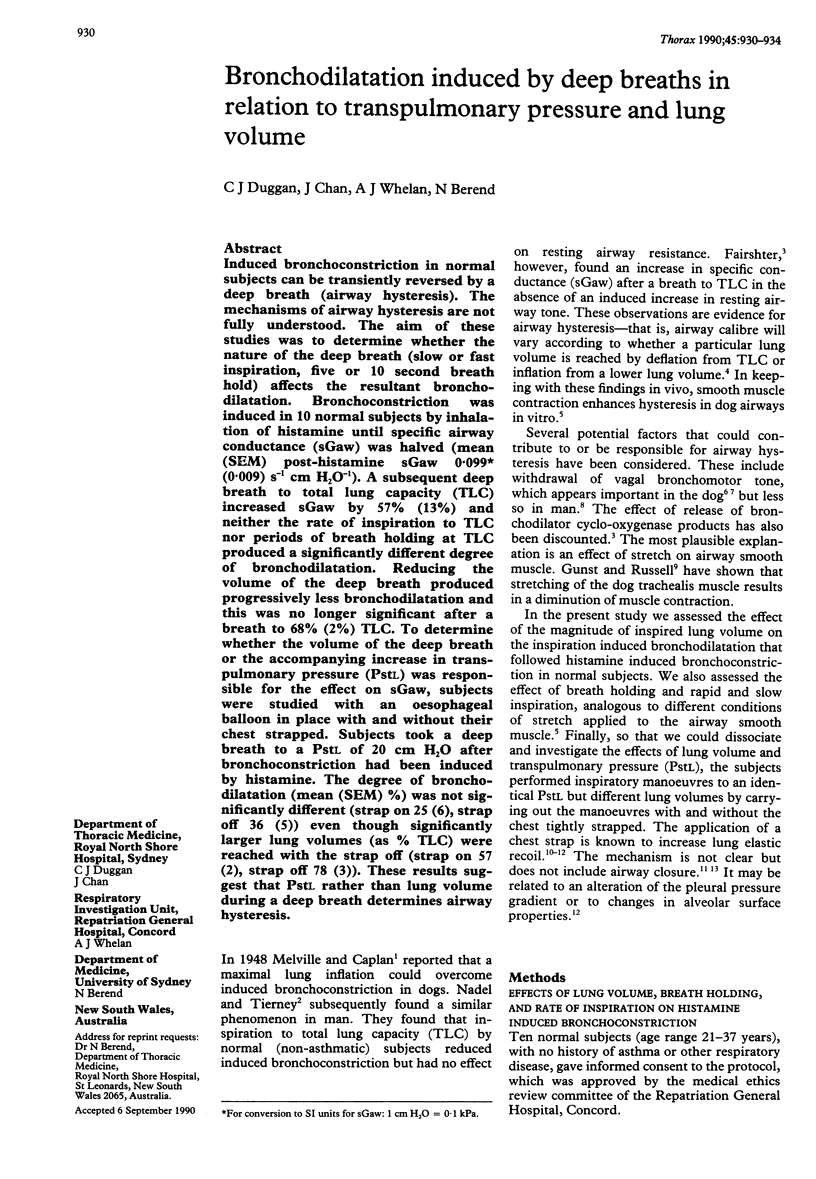
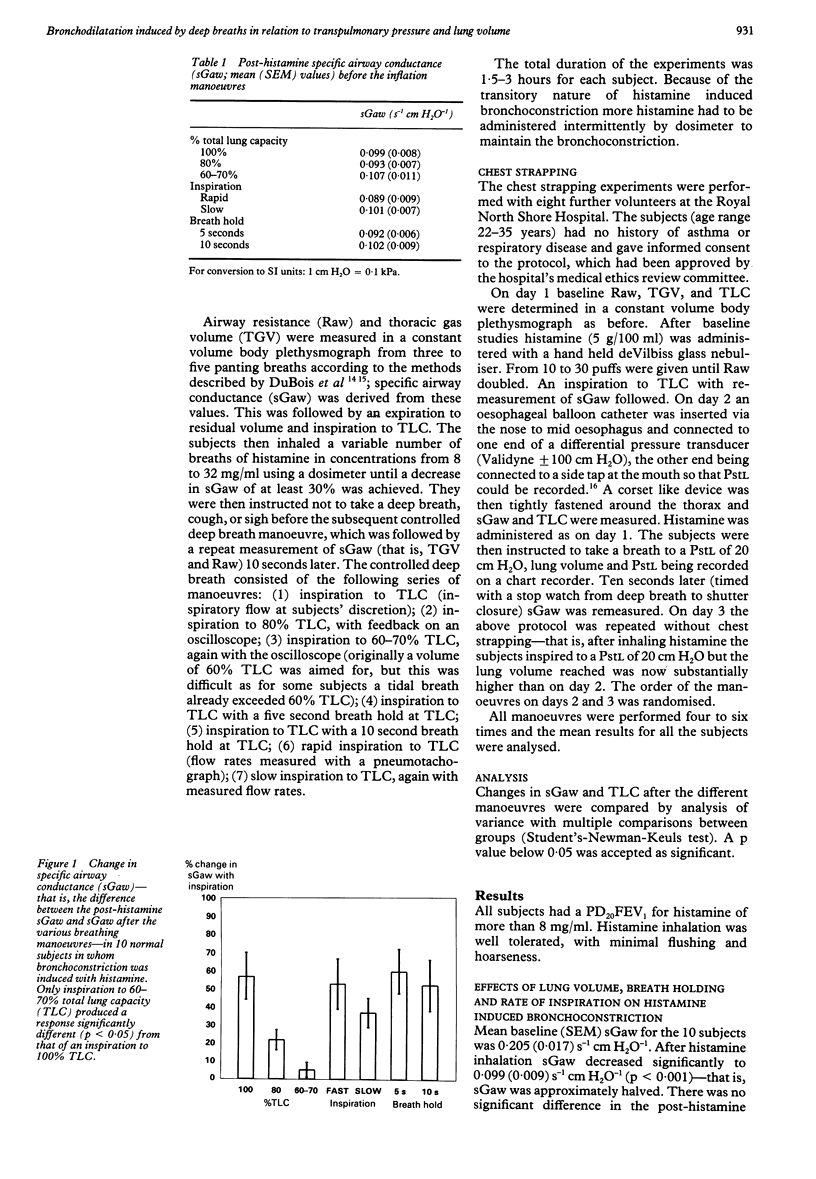
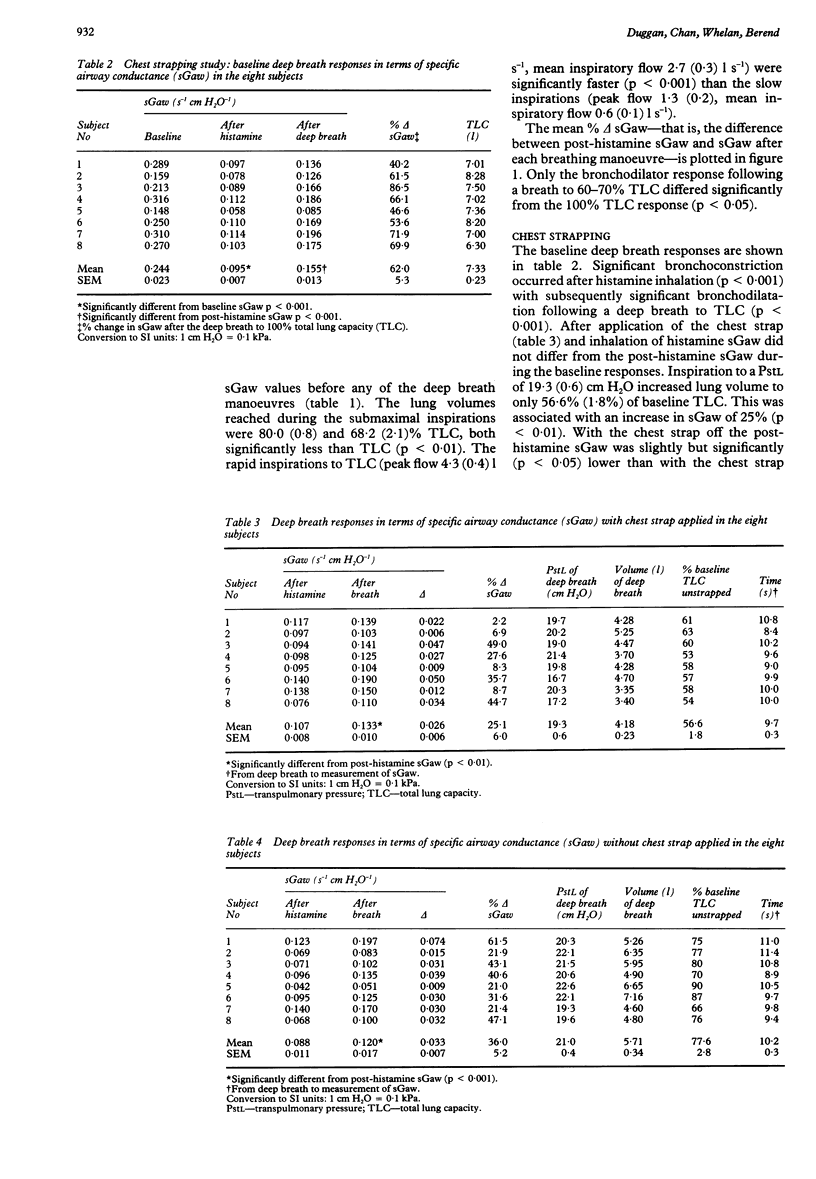
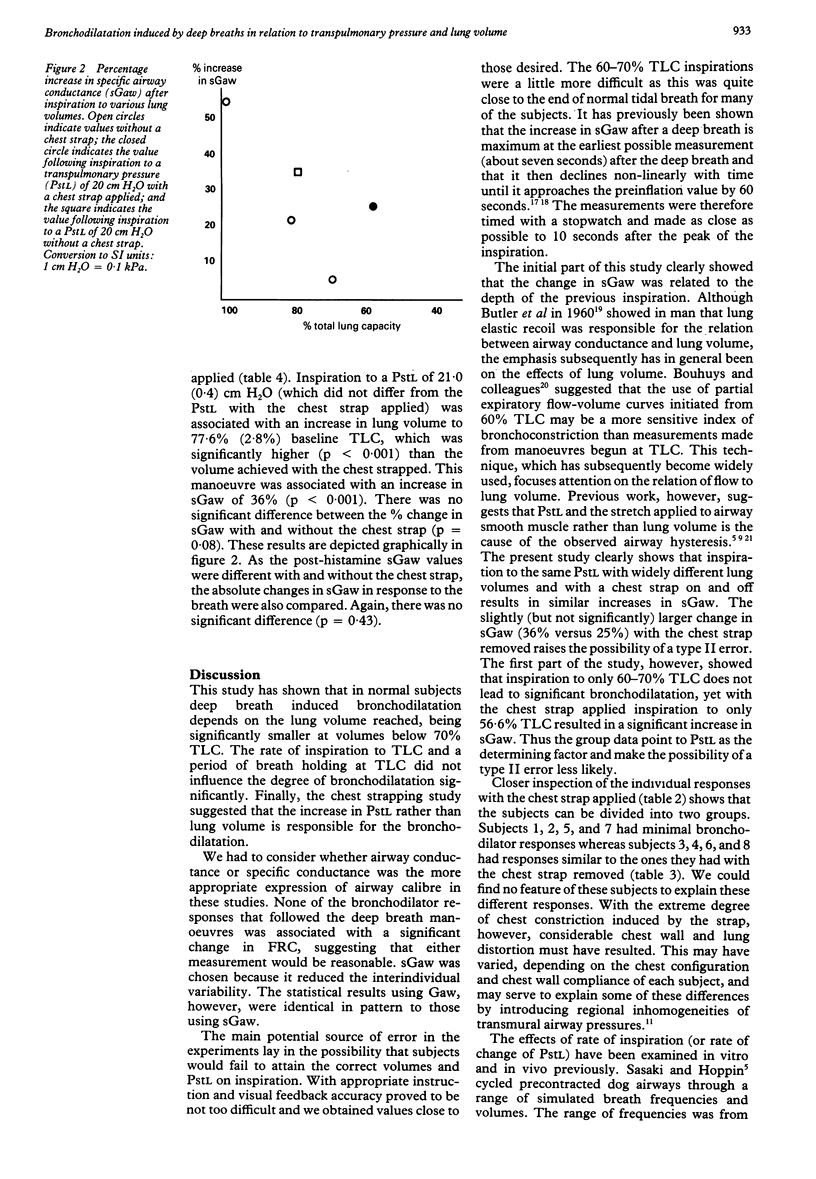
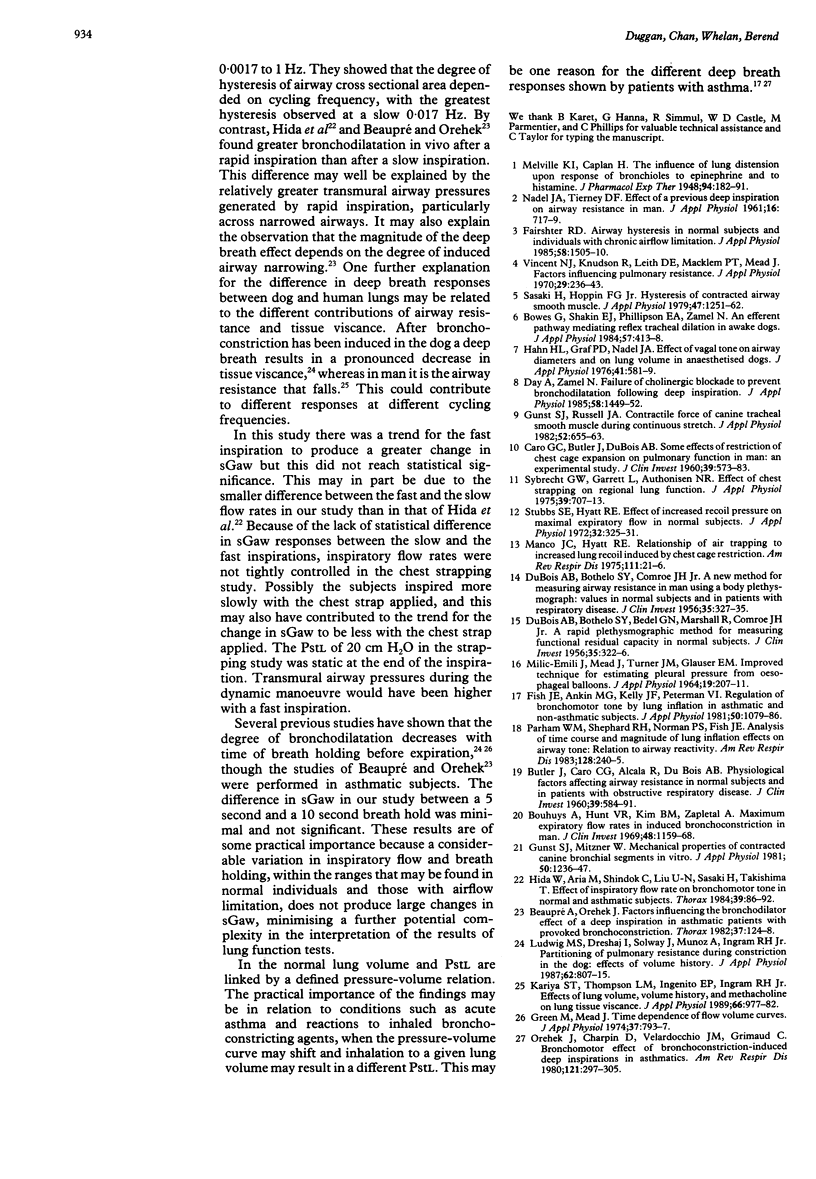
Selected References
These references are in PubMed. This may not be the complete list of references from this article.
- BUTLER J., CARO C. G., ALCALA R., DUBOIS A. B. Physiological factors affecting airway resistance in normal subjects and in patients with obstructive respiratory disease. J Clin Invest. 1960 Apr;39:584–591. doi: 10.1172/JCI104071. [DOI] [PMC free article] [PubMed] [Google Scholar]
- Beaupré A., Orehek J. Factors influencing the bronchodilator effect of a deep inspiration in asthmatic patients with provoked bronchoconstriction. Thorax. 1982 Feb;37(2):124–128. doi: 10.1136/thx.37.2.124. [DOI] [PMC free article] [PubMed] [Google Scholar]
- Bouhuys A., Hunt V. R., Kim B. M., Zapletal A. Maximum expiratory flow rates in induced bronchoconstriction in man. J Clin Invest. 1969 Jun;48(6):1159–1168. doi: 10.1172/JCI106073. [DOI] [PMC free article] [PubMed] [Google Scholar]
- Bowes G., Shakin E. J., Phillipson E. A., Zamel N. An efferent pathway mediating reflex tracheal dilation in awake dogs. J Appl Physiol Respir Environ Exerc Physiol. 1984 Aug;57(2):413–418. doi: 10.1152/jappl.1984.57.2.413. [DOI] [PubMed] [Google Scholar]
- CARO C. G., BUTLER J., DUBOIS A. B. Some effects of restriction of chest cage expansion on pulmonary function in man: an experimental study. J Clin Invest. 1960 Apr;39:573–583. doi: 10.1172/JCI104070. [DOI] [PMC free article] [PubMed] [Google Scholar]
- DUBOIS A. B., BOTELHO S. Y., BEDELL G. N., MARSHALL R., COMROE J. H., Jr A rapid plethysmographic method for measuring thoracic gas volume: a comparison with a nitrogen washout method for measuring functional residual capacity in normal subjects. J Clin Invest. 1956 Mar;35(3):322–326. doi: 10.1172/JCI103281. [DOI] [PMC free article] [PubMed] [Google Scholar]
- DUBOIS A. B., BOTELHO S. Y., COMROE J. H., Jr A new method for measuring airway resistance in man using a body plethysmograph: values in normal subjects and in patients with respiratory disease. J Clin Invest. 1956 Mar;35(3):327–335. doi: 10.1172/JCI103282. [DOI] [PMC free article] [PubMed] [Google Scholar]
- Day A., Zamel N. Failure of cholinergic blockade to prevent bronchodilatation following deep inspiration. J Appl Physiol (1985) 1985 May;58(5):1449–1452. doi: 10.1152/jappl.1985.58.5.1449. [DOI] [PubMed] [Google Scholar]
- Fairshter R. D. Airway hysteresis in normal subjects and individuals with chronic airflow obstruction. J Appl Physiol (1985) 1985 May;58(5):1505–1510. doi: 10.1152/jappl.1985.58.5.1505. [DOI] [PubMed] [Google Scholar]
- Fish J. E., Ankin M. G., Kelly J. F., Peterman V. I. Regulation of bronchomotor tone by lung inflation in asthmatic and nonasthmatic subjects. J Appl Physiol Respir Environ Exerc Physiol. 1981 May;50(5):1079–1086. doi: 10.1152/jappl.1981.50.5.1079. [DOI] [PubMed] [Google Scholar]
- Green M., Mead J. Time dependence of flow-volume curves. J Appl Physiol. 1974 Dec;37(6):793–797. doi: 10.1152/jappl.1974.37.6.793. [DOI] [PubMed] [Google Scholar]
- Gunst S. J., Mitzner W. Mechanical properties of contracted canine bronchial segments in vitro. J Appl Physiol Respir Environ Exerc Physiol. 1981 Jun;50(6):1236–1247. doi: 10.1152/jappl.1981.50.6.1236. [DOI] [PubMed] [Google Scholar]
- Gunst S. J., Russell J. A. Contractile force of canine tracheal smooth muscle during continuous stretch. J Appl Physiol Respir Environ Exerc Physiol. 1982 Mar;52(3):655–663. doi: 10.1152/jappl.1982.52.3.655. [DOI] [PubMed] [Google Scholar]
- Hahn H. L., Graf P. D., Nadel J. A. Effect of vagal tone on airway diameters and on lung volume in anesthetized dogs. J Appl Physiol. 1976 Oct;41(4):581–589. doi: 10.1152/jappl.1976.41.4.581. [DOI] [PubMed] [Google Scholar]
- Hida W., Arai M., Shindoh C., Liu Y. N., Sasaki H., Takishima T. Effect of inspiratory flow rate on bronchomotor tone in normal and asthmatic subjects. Thorax. 1984 Feb;39(2):86–92. doi: 10.1136/thx.39.2.86. [DOI] [PMC free article] [PubMed] [Google Scholar]
- Kariya S. T., Thompson L. M., Ingenito E. P., Ingram R. H., Jr Effects of lung volume, volume history, and methacholine on lung tissue viscance. J Appl Physiol (1985) 1989 Feb;66(2):977–982. doi: 10.1152/jappl.1989.66.2.977. [DOI] [PubMed] [Google Scholar]
- Ludwig M. S., Dreshaj I., Solway J., Munoz A., Ingram R. H., Jr Partitioning of pulmonary resistance during constriction in the dog: effects of volume history. J Appl Physiol (1985) 1987 Feb;62(2):807–815. doi: 10.1152/jappl.1987.62.2.807. [DOI] [PubMed] [Google Scholar]
- MILIC-EMILI J., MEAD J., TURNER J. M., GLAUSER E. M. IMPROVED TECHNIQUE FOR ESTIMATING PLEURAL PRESSURE FROM ESOPHAGEAL BALLOONS. J Appl Physiol. 1964 Mar;19:207–211. doi: 10.1152/jappl.1964.19.2.207. [DOI] [PubMed] [Google Scholar]
- Manço J. C., Hyatt R. E. Relationship of air trapping to increased lung recoil pressure induced by chest cage restriction. Am Rev Respir Dis. 1975 Jan;111(1):21–26. doi: 10.1164/arrd.1975.111.1.21. [DOI] [PubMed] [Google Scholar]
- NADEL J. A., TIERNEY D. F. Effect of a previous deep inspiration on airway resistance in man. J Appl Physiol. 1961 Jul;16:717–719. doi: 10.1152/jappl.1961.16.4.717. [DOI] [PubMed] [Google Scholar]
- Orehek J., Charpin D., Velardocchio J. M., Grimaud C. Bronchomotor effect of bronchoconstriction-induced deep inspirations in asthmatics. Am Rev Respir Dis. 1980 Feb;121(2):297–305. doi: 10.1164/arrd.1980.121.2.297. [DOI] [PubMed] [Google Scholar]
- Parham W. M., Shepard R. H., Norman P. S., Fish J. E. Analysis of time course and magnitude of lung inflation effects on airway tone: relation to airway reactivity. Am Rev Respir Dis. 1983 Aug;128(2):240–245. doi: 10.1164/arrd.1983.128.2.240. [DOI] [PubMed] [Google Scholar]
- Sasaki H., Hoppin F. G., Jr Hysteresis of contracted airway smooth muscle. J Appl Physiol Respir Environ Exerc Physiol. 1979 Dec;47(6):1251–1262. doi: 10.1152/jappl.1979.47.6.1251. [DOI] [PubMed] [Google Scholar]
- Stubbs S. E., Hyatt R. E. Effect of increased lung recoil pressure on maximal expiratory flow in normal subjects. J Appl Physiol. 1972 Mar;32(3):325–331. doi: 10.1152/jappl.1972.32.3.325. [DOI] [PubMed] [Google Scholar]
- Sybrecht G. W., Garrett L., Anthonisen N. R. Effect of chest strapping on regional lung function. J Appl Physiol. 1975 Nov;39(5):707–713. doi: 10.1152/jappl.1975.39.5.707. [DOI] [PubMed] [Google Scholar]
- Vincent N. J., Knudson R., Leith D. E., Macklem P. T., Mead J. Factors influencing pulmonary resistance. J Appl Physiol. 1970 Aug;29(2):236–243. doi: 10.1152/jappl.1970.29.2.236. [DOI] [PubMed] [Google Scholar]


